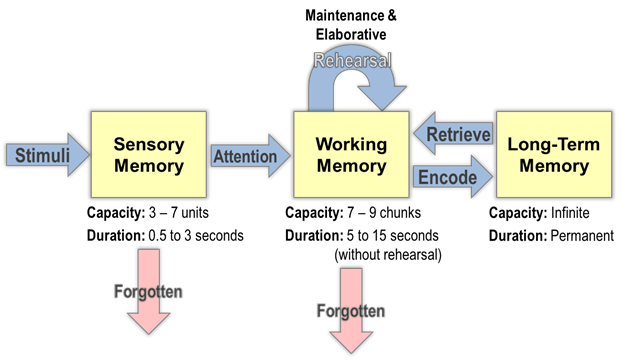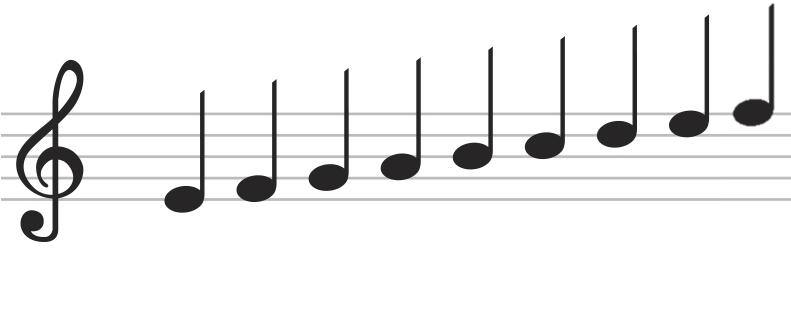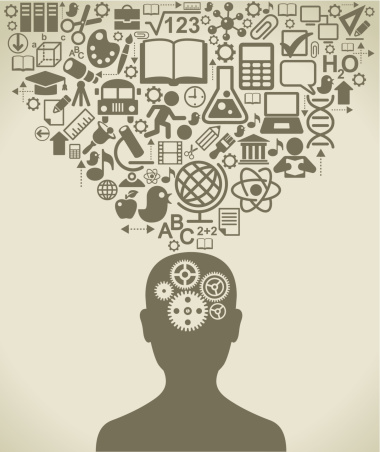A Primer on How Students (and All Humans) Learn
One of the struggles of teaching is presenting often complex material to students in a manner that they can comprehend. Through a basic understanding of how students (and all humans) learn, we, as teachers, can introduce content to our students in a way that will maximize the likelihood that learning will take place. The Information Processing Model provides us with a theory on how humans process information. Today, we will look at learning through the lens of the Information Processing Model, and discuss how to leverage this information to improve student achievement in the classroom.

Sensory Memory
The first stage of the informational processing model is the Sensory Memory, which provides the initial screening and processing of incoming stimuli. As the name suggests, Sensory Memory deals with any information that can be perceived through the five senses. In the classroom, students’ senses are being bombarded by different stimuli. Too much stimuli, in fact, for their brains to handle at once. This is where the Sensory Memory comes in. The Sensory Memory interacts with all of the incoming stimuli and helps decide what is important enough to direct attention to. The Sensory Memory has a very limited capacity and duration; it can only handle between 3-7 units, or stimuli, at a time and only for about 1- 3 seconds at a time before information is forgotten. A convenient way to think of the Sensory Memory is as a filter. It takes in the stimuli in the environment, gets rid of anything unimportant by forgetting, and focuses attention on information that is important.
Example
A student is learning to read sheet music for the first time. The student begins his/her lesson in a noisy band hall. Motivated by the student’s desire to play an instrument, the Sensory Memory filters out information unrelated to reading the music (e.g., people walking by, other instruments playing) and focuses attention on information relevant to reading the music (e.g., the lesson in front of him/her, the teacher’s voice).
Working Memory
Once it is decided that information is important enough for attention, it finds its way into Working Memory. The Working Memory provides temporary storage and manipulation of information being processed. So, now that students have decided something is important, they can begin to consciously interact with that information. With Working Memory, the capacity and duration are slightly longer than Sensory Memory, but not by much. Capacity of the Working Memory is considered to be, on average, 7 (plus or minus 2) chunks of information (Note: This capacity is the reason phone numbers and license plates are usually 7 digits long). Important to note here is the word “chunks.” This means the Working Memory is not necessary limited to 7 individual pieces of information. The human brain is very efficient at grouping information to make it easier to handle. Consider, for example, how our brain interacts with phone numbers. We do not think of it as individual digits, but groups, or “chunks,” of digits (area code – three digits – four digits). This is an example of chunking, which allows, in this case, for the consolidation of ten units of information into three “chunks” of information.

Example
When learning to read the notes of the treble clef, a student must know that the notes are (ascending from the bottom line) E–F–G –A–B –C–D–E–F. Rather than processing all of the notes together, the student can be directed to split the notes into two chunks, those on the line (E–G–B–D–F) and in the spaces (F–A–C– E). Now, instead of processing the information as 9 individual units, the student can organize it as two chunks of information.
We know the Working Memory can handle about 7 chunks of information at a time, but how long does it stay there? On average, the duration is about 5 – 15 seconds before it is forgotten. So, should information hold a student’s attention and enter Working Memory, if the student does not process that information in some way, it is forgotten within 5 – 15 seconds. This is where the Working Memory begins its job: it is the processing, called Rehearsal, that is important here.
Rehearsal
Rehearsal refers to the manipulation of information currently stored in Working Memory. Students are focused on this information, and need to interact with it in some way or it is forgotten. Rehearsal is the method of doing so. There are two main types of rehearsal: maintenance and elaborative. Maintenance Rehearsal is rehearsal in which a thought or an idea is repeated over and over in order to keep it in the Working Memory. Maintenance Rehearsal is useful at keeping, or maintaining, information in the Working Memory, but typically, information does not get much further, and is soon forgotten once attention is directed elsewhere. The second type of rehearsal is referred to as Elaborative Rehearsal. With Elaborative Rehearsal, rather than just repeating information over and over, some sort of meaning is attached to a term or piece of information. Through this process of attaching meaning in Elaborative Rehearsal, storage of the information is much more efficient, requiring fewer repetitions than with Maintenance Rehearsal. Generally, the goal of Rehearsal is Encoding, or the storage of information into Long-Term Memory.
Example
Once the student has chunked the notes into two groups, notes on the line (E–G–B–D–F) and notes in the spaces (F–A–C–E) the student can begin rehearsing this information. With Maintenance Rehearsal, the student could repeat the notes several times. Or, using Elaborative Rehearsal, the student could use the common mnemonic (Every Good Boy Does Fine) for notes on the line, and recognize the notes in the spaces spell out the word FACE. Attaching meaning through mnemonics makes the encoding process more efficient, requiring fewer repetitions than Maintenance Rehearsal.
Long-Term Memory
Through encoding, information has arrived at the final stage of the Information Processing Model: Long-Term Memory. Long-Term Memory provides permanent storage of information to later be retrieved. Unlike the previous two components of the Information Processing Model, Long-Term Memory is assumed to have (nearly) infinite capacity and permanent duration. If information is encoded effectively into Long-Term Memory, we can say that learning has occurred. However, simply encoding information in Long-Term Memory does a student no good if he or she cannot access it later. Accessing information stored in Long-Term Memory is referred to as Retrieval. Information encoded in Long-Term Memory cannot be interacted with directly. It must be retrieved from Long-Term Memory and brought back into Working Memory where the information can once again be processed.
Example
After encoding the notes of the treble clef in Long-Term Memory, the student is asked to read the notes on the staff above. To do so, the encoded information must be retrieved from Long-Term Memory and processed in the student’s Working Memory in order for the student to form a response. By reviewing the information regularly, the student will, in time, become more efficient at retrieving this information from Long-Term Memory.
Classroom Applications
Now that we have a basic understanding of the learning process, how can we apply this information to improve student performance in the classroom?
First and foremost, we must gain our students’ attention so the information is not quickly filtered out by their Sensory Memory. In a lesson this can be achieved through a clear, concise Learning Objective. By directly stating what students will do in a lesson, it becomes clear that the information we are about to present is important enough to warrant students’ attention.
Once new content is presented to students, it is vital to have students engaged in the lesson. Through a variety of cognitive and engagement strategies, it can be ensured that students are processing the information, which is vital for encoding information in Long-Term Memory. Consistently Checking for Understanding with Higher-Order Questions during a lesson makes certain that all students are making use of Elaborative Rehearsal to attach meaning to ideas presented in a lesson, making it easier for students to efficiently encode new information.
Finally, the learning process does not necessarily end after a lesson is finished, even if the majority of information is encoded in Long-Term Memory. Just as students need repetitions while rehearsing new information, they also need repetitions in retrieving previously learned information. This allows students to become more efficient in retrieving the information from their Long-Term Memory in the future. Reviewing learned content periodically provides students with the opportunity to access encoded information, increasing the likelihood they will be able to retrieve it come assessment time.





